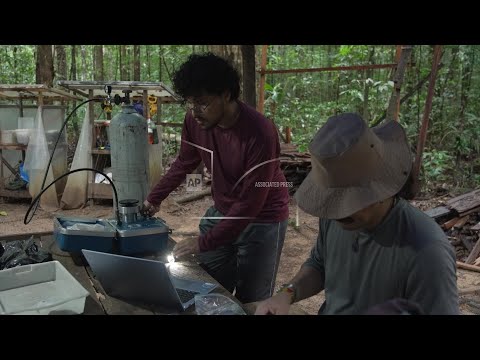(29 May 2025)
RESTRICTION SUMMARY:
ASSOCIATED PRESS
Caixuana National Forest, Brazil – 22 March 2025
1. Aerial shot of Amazon forest ++MUTE++
ASSOCIATED PRESS
Caixuana National Forest, Brazil – 20 March 2025
2. Various of Vice Coordinator of Esecaflor, João de Athaydes walking through the forest
3. SOUNDBITE (Portuguese) João de Athaydes, Vice Coordinator of Esecaflor:
“The Esecaflor Project started in 2000 with the goal of understanding how the Amazon rainforest behaves in drought events.”
4. Various of remains of transparent plastic panels that was used to divert rainfall in the study plot.
5. SOUNDBITE (Portuguese) João de Athaydes, Vice Coordinator of Esecaflor:
“The project consists of two plots of one acre each. One plot is totally natural, with no human intervention. And the other plot we covered with plastic panels, keeping the vegetation without damaging it, with the goal of reducing the amount of water that reaches the forest.”
6. Close of ants crawling over fallen leaves
7. Close of a spider next to a data collection box
8. Various of a researcher collecting data on a computer
9. SOUNDBITE (Portuguese) João de Athaydes, Vice Coordinator of Esecaflor:
“Currently, it is the longest running project in the planet.”
10. Various of sensors on trees
11. Wide of researchers collecting data from sensors in the forest
12. Various of rain falling
13. SOUNDBITE (Portuguese) João de Athaydes, Vice Coordinator of Esecaflor:
“The drought has already happened, the forest has already adapted. Now we want to understand what happens next.”
14. Various of researchers collecting data
15. SOUNDBITE (English) Rachel Selman, Researcher at the University of Edinburgh:
“We know very little about how drought and climate change influences soil processes.”
16. Various of researchers studying plants leaves
17. SOUNDBITE (English) Rachel Selman, Researcher at the University of Edinburgh:
“We know that soil in the tropics store around a third of total carbon stocks and it’s also essential for the cycling of nutrients. So we need to understand more about how future climate change scenarios like drought and more extreme drought events could influence how soils are able to recycle nutrients and store carbon.”
ASSOCIATED PRESS
Caixuana National Forest, Brazil – 22 March 2025
18. Various aerial shots of the rainforest and rivers in the Caxiuanã National Forest region ++MUTE++
STORYLINE:
A short walk beneath the dense Amazon canopy, the forest abruptly opens up. Fallen logs are rotting, the trees grow sparser and the temperature rises in places sunlight hits the ground. This is what 24 years of severe drought looks like in the world’s largest rainforest.
But this patch of degraded forest, about the size of a soccer field, is a scientific experiment. Launched in 2000 by Brazilian and British scientists, Esecaflor — short for “Effects of Forest Drought” in Portuguese— set out to simulate a future in which the changing climate could deplete the Amazon of rainfall. It is the longest-running project of its kind in the world, and has become a source for dozens of academic articles in fields ranging from meteorology to ecology and physiology.
Next to it, an identical plot was left untouched to serve as a control. In both areas, instruments were attached to trees, both placed on the ground and buried to measure soil moisture, air temperature, tree growth, sap flow and root development, among other data. Two metal towers sit above each plot.
During a visit in April, Athaydes guided AP through the site, which had many researchers.
___
Find out more about AP Archive: http://www.aparchive.com/HowWeWork
Twitter: https://twitter.com/AP_Archive
Facebook: https://www.facebook.com/APArchives
Instagram: https://www.instagram.com/APNews/
You can license this story through AP Archive: http://www.aparchive.com/metadata/youtube/1f853115bed143c2b7adc45ae48e71ae
Author: AP Archive
Go to Source
News post in June 3, 2025, 12:06 pm.
Visit Our Sponsor’s:
News Post In – News





